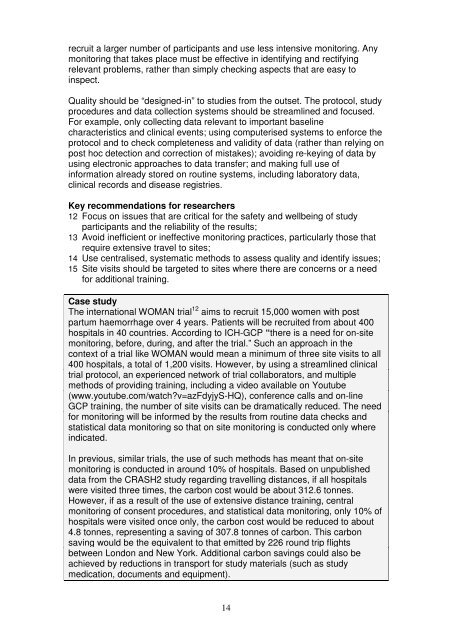The NIHR Carbon Reduction Guidelines
The NIHR Carbon Reduction Guidelines
The NIHR Carbon Reduction Guidelines
You also want an ePaper? Increase the reach of your titles
YUMPU automatically turns print PDFs into web optimized ePapers that Google loves.
ecruit a larger number of participants and use less intensive monitoring. Anymonitoring that takes place must be effective in identifying and rectifyingrelevant problems, rather than simply checking aspects that are easy toinspect.Quality should be “designed-in” to studies from the outset. <strong>The</strong> protocol, studyprocedures and data collection systems should be streamlined and focused.For example, only collecting data relevant to important baselinecharacteristics and clinical events; using computerised systems to enforce theprotocol and to check completeness and validity of data (rather than relying onpost hoc detection and correction of mistakes); avoiding re-keying of data byusing electronic approaches to data transfer; and making full use ofinformation already stored on routine systems, including laboratory data,clinical records and disease registries.Key recommendations for researchers12 Focus on issues that are critical for the safety and wellbeing of studyparticipants and the reliability of the results;13 Avoid inefficient or ineffective monitoring practices, particularly those thatrequire extensive travel to sites;14 Use centralised, systematic methods to assess quality and identify issues;15 Site visits should be targeted to sites where there are concerns or a needfor additional training.Case study<strong>The</strong> international WOMAN trial 12 aims to recruit 15,000 women with postpartum haemorrhage over 4 years. Patients will be recruited from about 400hospitals in 40 countries. According to ICH-GCP “there is a need for on-sitemonitoring, before, during, and after the trial.” Such an approach in thecontext of a trial like WOMAN would mean a minimum of three site visits to all400 hospitals, a total of 1,200 visits. However, by using a streamlined clinicaltrial protocol, an experienced network of trial collaborators, and multiplemethods of providing training, including a video available on Youtube(www.youtube.com/watch?v=azFdyjyS-HQ), conference calls and on-lineGCP training, the number of site visits can be dramatically reduced. <strong>The</strong> needfor monitoring will be informed by the results from routine data checks andstatistical data monitoring so that on site monitoring is conducted only whereindicated.In previous, similar trials, the use of such methods has meant that on-sitemonitoring is conducted in around 10% of hospitals. Based on unpublisheddata from the CRASH2 study regarding travelling distances, if all hospitalswere visited three times, the carbon cost would be about 312.6 tonnes.However, if as a result of the use of extensive distance training, centralmonitoring of consent procedures, and statistical data monitoring, only 10% ofhospitals were visited once only, the carbon cost would be reduced to about4.8 tonnes, representing a saving of 307.8 tonnes of carbon. This carbonsaving would be the equivalent to that emitted by 226 round trip flightsbetween London and New York. Additional carbon savings could also beachieved by reductions in transport for study materials (such as studymedication, documents and equipment).14

















